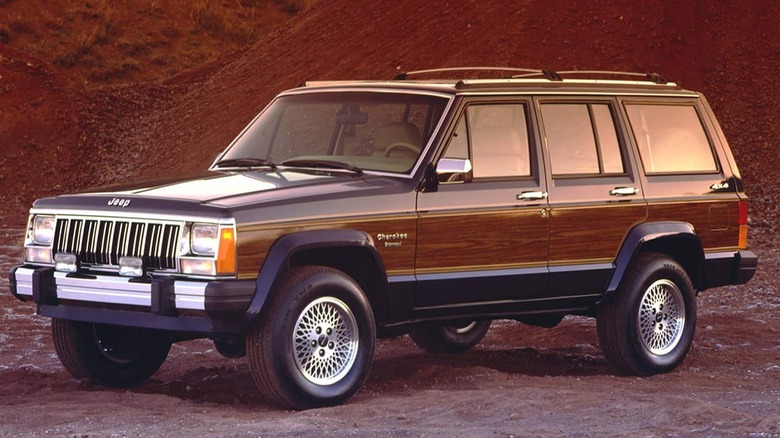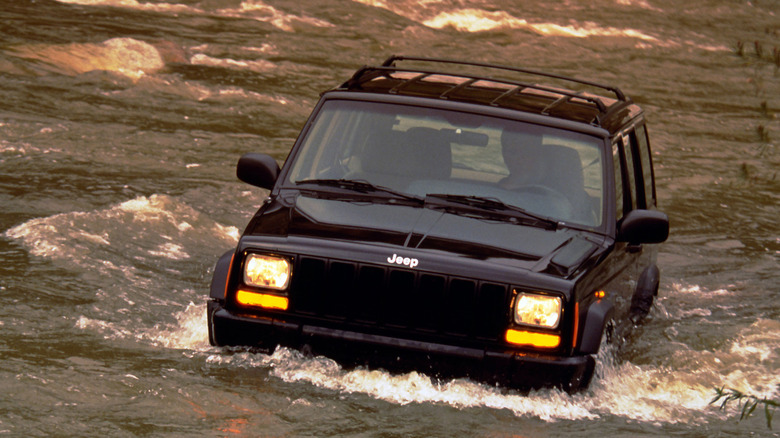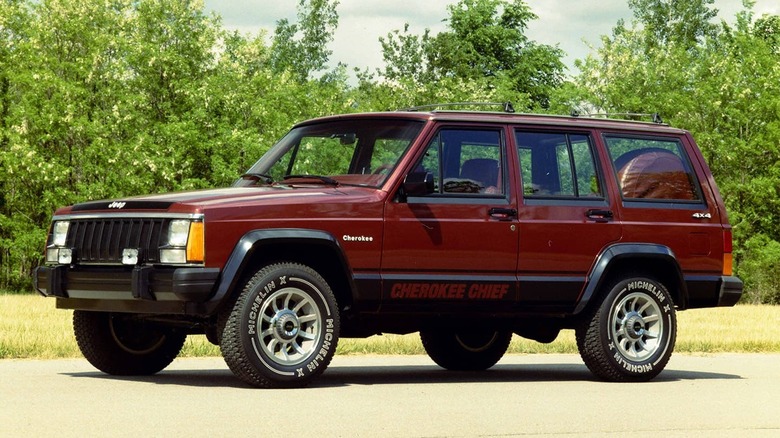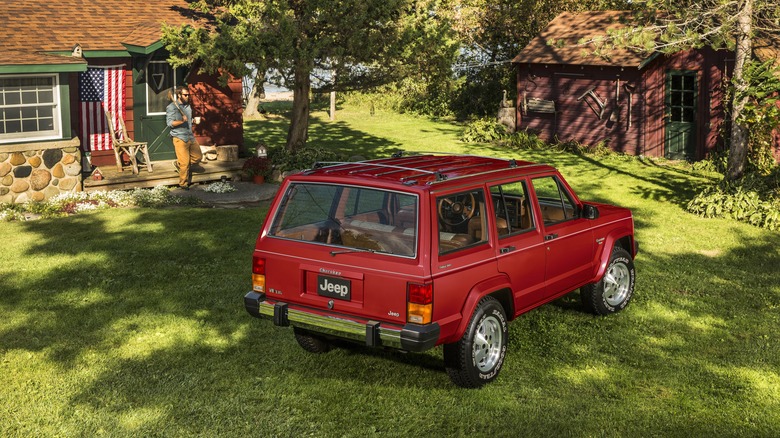Are Jeep Cherokees Reliable After 100k Miles? Here's What Owners Have To Say
I'm a woman who takes driving rather seriously. I started off as a mechanic before doing delivery work to pay for college, racking up hundreds of thousands of miles of driving local and long-distance in the process. And my vehicle of choice throughout that whole time was a classic Jeep Cherokee — a timeless compact SUV with a reputation for being simple, bulletproof, and easy to maintain. But how reliable are they, really?
Generally, vehicles with such reputations have rightfully earned them, and the classic Cherokee XJ is no exception. Both the 2.5-liter inline-four and 4.0-liter straight-six are beloved by Jeep owners and experts alike, with a significant fraction of these engines that are still on the road likely having exceeded the six-figure mark by now. The rest of the powertrain is quite durable, with both manual and automatic transmissions, as well as the various transfer cases these vehicles employed, generally proving equally reliable. Despite the years and miles, the XJ platform continues to impress, provided it is well-maintained and kept clean. Let's look under the hood and see why, from the perspective of long-term ownership and those within the classic Jeep community.
As a quick disclaimer, this article addresses classic Cherokee XJs only, not modern ones. The classic models are the progenitors of its reliable reputation and the ones most likely to have racked up more than 100,000 miles. Moreover, being older vehicles, the question of longevity is more relevant if someone wishes to daily drive a classic car. That said, modern Cherokees are generally considered to be fairly reliable trucks as well, with 2024 models ranked number 9 or 26 on RepairPal for compact SUV reliability.
The highlights of classic Cherokee reliability
From an engineering standpoint, both the 2.5- and 4.0-liter engines are exceptionally durable, being overbuilt but simple engines, with designs dating back over six decades at this point. Being derived from the 4.0's design, the 2.5 provides a cheaper and more economical entry point while still being extremely reliable. The 4.0-liter engine grants additional power and capability at the cost of some fuel economy. My own '96 Cherokee, which is a 4.0 High-Output with a five-speed transmission and ~212,000 miles, gets about 15 mpg on average, for context — I often joke that what I save at the mechanic, I spend at the gas station.
These engines' strengths lie in their simplicity, with a robust, if somewhat anachronistic design. These were old-school cast-iron block and head pushrod engines boasting parts interchangeability with 1970s designs, but which were manufactured until the Wrangler TJ's demise in 2006. This makes both engines easy for beginners to maintain, with excellent parts availability, ease of access, and overbuilt components, all points cited by expert reviewers. Owner opinions are similar, celebrating aspects such the inline-6's simple, balanced construction and the engine's understressed and refined design, with many claiming to have hit 200,000 or more miles on their Cherokees and Wranglers.
As for the rest of the Cherokee platform, it's a unibody, meaning the body is a stressed member. This reduced weight and improved its center of gravity, making it well-suited for off-roading. Aside from this, it's mechanically nearly identical to the Wrangler, which means solid axles and 4x4 underpinnings. While frequently replaced in serious off-roaders, I've only needed to change my factory shocks once in my daily driver.
Downsides to watch out for
Firstly, being a unibody means you can't get away with rust, and the older you go, the more rust you're likely to encounter. Because the body provides the stiffness, rust will compromise that — so finding a clean, rust-free Cherokee is important for longevity. Similarly, because these trucks are over 25 years old now, they almost always feature some wear in perishable components such as rubber bushings, ball joints, and so on. Along with suspension and steering wear and tear, this leads to the frightening phenomenon owners call the "death wobble," where the Jeep shakes violently at highway speeds.
Iffy electrics is another problem area for Jeep owners. My family-owned 2001 Cherokee, bought new and now with ~250,000 miles, has one functional speaker, a broken driver's side power lock, windows that don't come down, and one bad distributor — all relatively easy but annoying fixes. The most major mechanical issue that plagues these late-model Cherokees, however, is the cylinder head. The infamous 0331-code cylinder head is known for cracking between cylinders 3 and 4, a problem that happened with my mother's 2001; she needed a rebuild at 76,000 miles, covered under warranty. Generally, in my experience, the sweet spot is '97-'99 for new bodies, and '91-'96 for old bodies.
Overall, there aren't many unexpected downsides. The solid axles lend a somewhat stiff, rough ride for daily driving, but are exceptionally durable if not abused; the engine's low-end torque and understressed nature favors longevity over performance; and the unibody demands maintenance to maintain rigidity. All else being equal, however, there's a reason you see so many on the roads today, and it's not just because they're the first truly modern SUVs.
My experience and research methodology
My family has owned Jeep Cherokees and their derivatives since the early 1990s, including five XJs, every Grand Cherokee generation up to 2007, and the first-gen Commander; I cut my teeth working on these vehicles, and know their systems intimately. I myself have studied cars, motorsports, and automotive history for over two decades, working in the automotive industry for several years before writing professionally about cars. I've owned several Cherokees myself, and my current daily has been with me since 2010.
I combined my own experience with expert and owner testimonials I found online, combing through forums, journals, and videos to refute or reinforce any points I've encountered over the years. In total, I drew on information from roughly two dozen websites in my search to provide the most accurate and relevant talking points when shopping for these classic Jeeps, so that potential owners know about the specific idiosyncrasies inherent to this platform.
Being classics, Jeep Cherokee XJs are subject to all the usual classic car caveats; poorly-maintained examples will fail readily, and projects requiring TLC are commonplace. Always look under the car, check for rust or damage, and go for a test drive before committing to a purchase.



